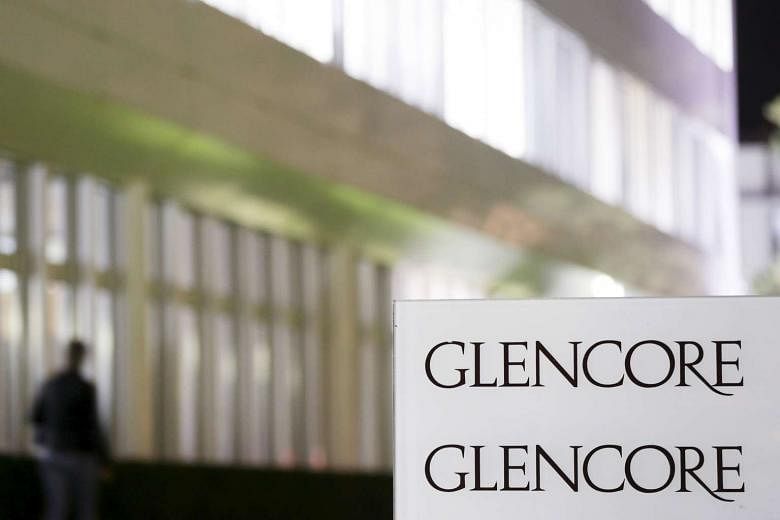LONDON (REUTERS) - As Glencore's stock went into free fall in August in the face of heavy debts and shrinking earnings, its chief Ivan Glasenberg had a defiant message - traders can beat weak commodity prices during market downturns.
But while analysts and investors were trying to figure out how trading could save a company in crisis, several traders were leaving the firm after what industry sources said were trades that failed to reward the big risks taken and the large amounts of capital employed.
The departures of Edmund Lau and Tay Meng Yee from Glencore's fuel oil desk in Singapore in August and this month's departure of the global head of fuel oil, London-based Yannick Fedele, came after Glencore bet big in the world's top fuel oil and ship refuelling market in Singapore.
Industry sources say Glencore, together with a number of rivals, wrongly bet on a bull market for fuel oil. Sources close to Glencore say money wasn't actually lost, the products desk would expand and Fedele's departure was not linked to the events in Singapore.
But whatever the result, it shows that the bet on trading as a saviour in a crisis is far from straightforward and will require all the skill and experience of hundreds of traders to prove that Glencore's unique model works.
Glasenberg's model was based on expanding the huge merchant of oil, coal, metals and grains into production by borrowing over US$30 billion to buy coal and copper mines.
The idea was simple - during commodity price booms coal and copper generate huge returns. During downturns, trading would pay the bills as it thrives on market volatility.
As mining normally generates around three quarters of Glencore's earnings, trading was generally ignored by the market after Glencore's record US$10 billion share placement in 2011, which turned Mr Glasenberg and fellow traders into billionaires.
But as commodities began their slide last year, trading came under the spotlight.
In March, Mr Glasenberg predicted confidently that oil trading - the historic core of the company which began as Marc Rich in the 1970s and was renamed Glencore in the 1990s - could "blow out the lights in 2015".
In the second quarter, oil trading still performed well but Glencore blamed "market headwinds in aluminium and nickel" for lower than expected trading earnings of US$1.1 billion, down from US$1.5 billion in the first half of 2014.
However, if a year ago trading represented 40 per cent of the overall adjusted earnings before interest and tax (EBIT), this year trading made almost 80 per cent of EBIT in the first half.
Reliance on trading is set to rise in the second half when Glencore expects it to deliver US$1.4-1.5 billion on the back of improvement in metals and agriculture.
"Trading is often similar to betting. Glencore has done it well for decades and they have one of the most talented teams. But to actually guarantee certain performance for trading is a bit brave," said a top executive at a rival.
Glencore well knows that trading is a risk-taking business.
When in 1993, the founder of Glencore and US fugitive Marc Rich tried to corner the zinc market, the attempt went wrong, costing the company US$170 million. It led to a revolt against Mr Rich and a management buyout, which saw the company renamed Glencore and Mr Glasenberg ultimately taking over.
More recently, Glencore lost up to US$300 million in a very volatile cotton market in 2011. Glencore was not the only casualty and many rivals were also hurt.
Beyond 2015, Glencore is confident it can earn even more from trading with its own estimates ranging between US$2.7 billion and US$3.7 billion a year as it boosts its presence in key markets. Glencore trades over three per cent of oil globally.
Glencore market jitters focus on a straightforward dilemma: will the company earn enough to service its debt when China is cutting its use of coal and copper?
Glencore has pledged to cut its net debt to US$20 billion from US$30 billion so even if copper and coal prices remain low and its earnings drop, it can service its debt and keep an investment grade rating.
But there are also a myriad of unknowns which are atypical for a FTSE 100 company.
Most analysts say that even though they understand Glencore's mining division, their models are of no use to calculate forward earnings of the trading division as Glencore discloses very little, like private rivals such as Vitol.
What confuses the market further are huge commodities inventories that Glencore traders are sitting on.
The inventories stood at US$18 billion as of June 30, down from US$19.5 billion a year earlier, but whether they are oil or copper or aluminium is anyone's guess.
Technically, inventories could be added to Glencore's debt - bringing the total to a huge US$50 billion - although the company argues inventories could be sold and turned into cash at any moment and therefore should not be counted as debt.
"All inventories are fully hedged. So in case they were to be sold overnight, the company would mitigate all price risks,"a source close to the company said.
However, confusion over the way trading operates has repeatedly caused huge volatility of Glencore's stock even in the absence of hard news.
The stock tanked 29 per cent on Monday after bank Investec said it saw a scenario under which Glencore would direct all its earnings toward debt repayment.
Last week, Goldman Sachs said that because Glencore's trading relied heavily on short-term credit, its financing costs would soar if it were to lose its rating.
Glencore points that it had available undrawn credit facilities and cash of as much as US$10.5 billion at the end of June, compared to its US$3 billion minimum threshold requirement.
"Even if we were to lose our investment grade rating, the overall costs for the group would increase by just US$5 million a year," one source close to Glencore said.

